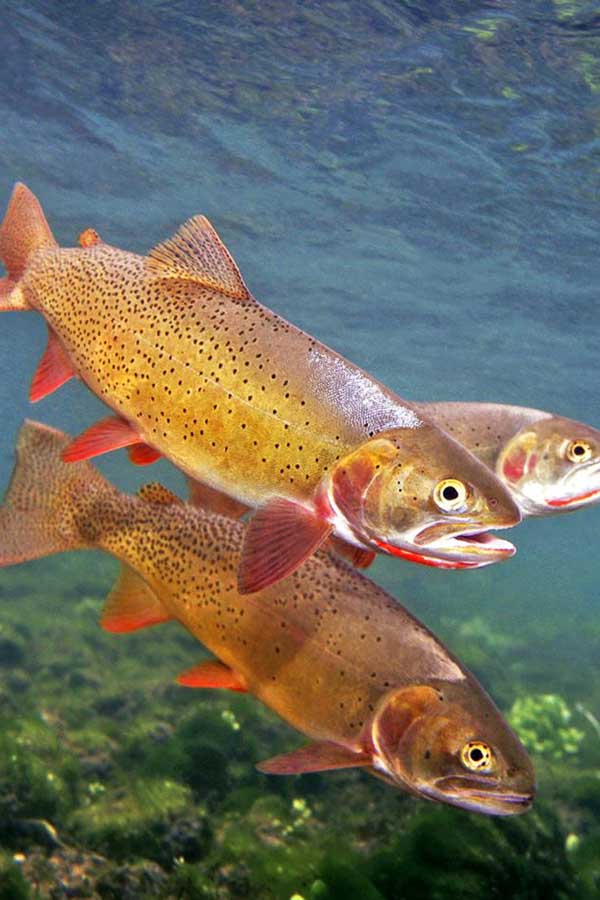The Lamar is the namesake of one of the most beautiful areas of Yellowstone National Park, the Lamar Valley. Though the river flows for over 40 miles in all, it is this 7 mile stretch that has made the Lamar famous in fly fishing circles. Though Rainbow Trout have encroached over the years, the river remains a stronghold for the native Yellowstone Cutthroats. The Lamar begins high in the Absaroka Mountains and traverses 30 miles of serious wilderness before reaching the road at its confluence with Soda Butte Creek. Below the Lamar Valley is another 8 miles of mostly canyon water before the Lamar spills into the Yellowstone River. While the Lamar Valley is of the most interest to anglers, there is plenty to explore for the adventurous type.
Fly-Fishing the Lamar River Overview
The Lamar is the last river in Yellowstone Park to clear from spring runoff, which subsides here in the middle of July, even later during big snow years. The river is also susceptible to summer thunderstorms, which can muddy the water for several days. With that being said, clear water periods offer dry fly fishing throughout the summer. Hatches, especially of Drakes, bring fish to the surface but the main draw is terrestrial fishing with hoppers, ants, and beetles. The other draw is the size of the fish, which average in the mid-teens” in the Lamar Valley. They don’t always come easy, however, and these cutthroats have their idiosyncrasies. They rise to the fly at an agonisingly slow pace, often resulting in premature hooksets. These fish also tend to move around within the river in a not always predictable pattern. Here one day gone the next; the Lamar is in constant flux.
Fishing the Lamar River- Headwaters to Soda Butte Creek
The headwaters of the Lamar lie in serious wilderness: steep, canyon country with small trout. Closer to Soda Butte Creek (and the road access), the river flattens out and the trout increase in size, with 10-14” becoming common. This stretch of river will fish well in late July and August, and the fish will be less sophisticated than those in the Lamar Valley. Attractor patterns and hoppers should cover things, especially as you get further from the road. Soda Butte is a major tributary, so the Lamar is noticeably smaller in this reach as well.
Fishing the Lamar River - Lamar Valley
The river seriously flattens here, with short riffle sections interspersed between long glides and runs. Your fly selection, leader, and presentation become critically important as the trout are far less forgiving than those smaller specimens upstream. Be on the lookout for hatches of Drakes- which can be green, grey or tan. Pale Morning Duns are also present, but do not get the fish going the same way the Drakes do. What really makes the Lamar famous is the terrestrial fishing. Hopper fishing is usually in full swing by the time the river finally clears. By mid to late August the trout have seen so many hopper patterns that beetles and ants become a good change of pace, especially if you are getting refusals from fish. September fishing can be difficult, as low, clear water combined with a summers worth of pressure has taken its toll on the fish. There is a smaller tan Drake (Hecuba) that hatches and makes the fish forget about all that, but otherwise downsize your tackle and flies and try to sight fish if possible.
One of the quirks of this section of river is that the fish move around and do not always hold in the same, or obvious, spots. I have been skunked in magnificent looking pools only to find fish practically rising on top of each other along a shallow bank upstream. Try to approach the river with an open mind, and don’t get too caught up in trying to fish the Lamar exactly like you would other rivers.
Fishing the Lamar River - Lamar Valley to Yellowstone River Confluence
Due to inconsistent fish populations, this 7 mile stretch of river sees far less angling pressure than the other sections. The Northeast Entrance Road crosses this section, with the bridge dividing it roughly in half. Upstream, the river crashes through a shallow but steep canyon full of car sized boulders. Downstream, the gradient eases and the river is a hybrid of meadow and canyon. The canyon upstream from the bridge can fish well. Salmon Flys and Golden Stones hatch here as the water clears. Hoppers and attractors that work upstream will take fish here throughout the summer. Large nymphs and streamers worked around the boulders can produce as well. Although it is located along the road, this stretch is very rugged and should be reserved for anglers who are confident waders and comfortable scrambling among the boulders.
The section of river downstream of the bridge to the confluence of the Yellowstone is not highly regarded as a fishery. The trout are mostly small and not as numerous as elsewhere. That’s not to say you can’t catch fish here, it’s just not a major destination.




